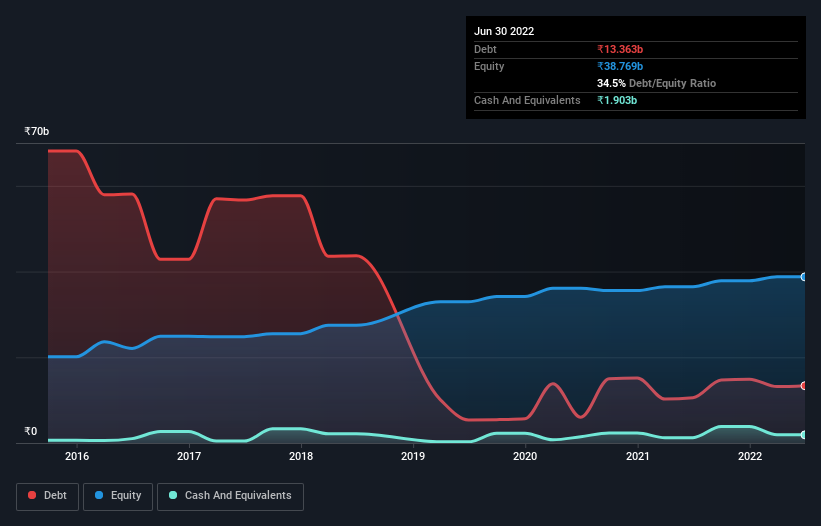- India
- /
- Paper and Forestry Products
- /
- NSEI:ABREL
Century Textiles and Industries (NSE:CENTURYTEX) Seems To Use Debt Quite Sensibly
David Iben put it well when he said, 'Volatility is not a risk we care about. What we care about is avoiding the permanent loss of capital.' It's only natural to consider a company's balance sheet when you examine how risky it is, since debt is often involved when a business collapses. Importantly, Century Textiles and Industries Limited (NSE:CENTURYTEX) does carry debt. But is this debt a concern to shareholders?
When Is Debt A Problem?
Debt assists a business until the business has trouble paying it off, either with new capital or with free cash flow. If things get really bad, the lenders can take control of the business. However, a more frequent (but still costly) occurrence is where a company must issue shares at bargain-basement prices, permanently diluting shareholders, just to shore up its balance sheet. Of course, plenty of companies use debt to fund growth, without any negative consequences. When we think about a company's use of debt, we first look at cash and debt together.
View our latest analysis for Century Textiles and Industries
What Is Century Textiles and Industries's Debt?
The image below, which you can click on for greater detail, shows that at March 2022 Century Textiles and Industries had debt of ₹13.4b, up from ₹10.5b in one year. However, it does have ₹1.90b in cash offsetting this, leading to net debt of about ₹11.5b.

A Look At Century Textiles and Industries' Liabilities
According to the last reported balance sheet, Century Textiles and Industries had liabilities of ₹28.4b due within 12 months, and liabilities of ₹10.2b due beyond 12 months. Offsetting these obligations, it had cash of ₹1.90b as well as receivables valued at ₹3.03b due within 12 months. So its liabilities outweigh the sum of its cash and (near-term) receivables by ₹33.7b.
This deficit isn't so bad because Century Textiles and Industries is worth ₹98.9b, and thus could probably raise enough capital to shore up its balance sheet, if the need arose. However, it is still worthwhile taking a close look at its ability to pay off debt.
We measure a company's debt load relative to its earnings power by looking at its net debt divided by its earnings before interest, tax, depreciation, and amortization (EBITDA) and by calculating how easily its earnings before interest and tax (EBIT) cover its interest expense (interest cover). This way, we consider both the absolute quantum of the debt, as well as the interest rates paid on it.
We'd say that Century Textiles and Industries's moderate net debt to EBITDA ratio ( being 2.4), indicates prudence when it comes to debt. And its strong interest cover of 12.5 times, makes us even more comfortable. Notably, Century Textiles and Industries's EBIT launched higher than Elon Musk, gaining a whopping 184% on last year. The balance sheet is clearly the area to focus on when you are analysing debt. But you can't view debt in total isolation; since Century Textiles and Industries will need earnings to service that debt. So when considering debt, it's definitely worth looking at the earnings trend. Click here for an interactive snapshot.
Finally, while the tax-man may adore accounting profits, lenders only accept cold hard cash. So the logical step is to look at the proportion of that EBIT that is matched by actual free cash flow. Over the last three years, Century Textiles and Industries recorded negative free cash flow, in total. Debt is far more risky for companies with unreliable free cash flow, so shareholders should be hoping that the past expenditure will produce free cash flow in the future.
Our View
Both Century Textiles and Industries's ability to to cover its interest expense with its EBIT and its EBIT growth rate gave us comfort that it can handle its debt. But truth be told its conversion of EBIT to free cash flow had us nibbling our nails. When we consider all the elements mentioned above, it seems to us that Century Textiles and Industries is managing its debt quite well. Having said that, the load is sufficiently heavy that we would recommend any shareholders keep a close eye on it. When analysing debt levels, the balance sheet is the obvious place to start. But ultimately, every company can contain risks that exist outside of the balance sheet. For example Century Textiles and Industries has 2 warning signs (and 1 which shouldn't be ignored) we think you should know about.
When all is said and done, sometimes its easier to focus on companies that don't even need debt. Readers can access a list of growth stocks with zero net debt 100% free, right now.
New: Manage All Your Stock Portfolios in One Place
We've created the ultimate portfolio companion for stock investors, and it's free.
• Connect an unlimited number of Portfolios and see your total in one currency
• Be alerted to new Warning Signs or Risks via email or mobile
• Track the Fair Value of your stocks
Have feedback on this article? Concerned about the content? Get in touch with us directly. Alternatively, email editorial-team (at) simplywallst.com.
This article by Simply Wall St is general in nature. We provide commentary based on historical data and analyst forecasts only using an unbiased methodology and our articles are not intended to be financial advice. It does not constitute a recommendation to buy or sell any stock, and does not take account of your objectives, or your financial situation. We aim to bring you long-term focused analysis driven by fundamental data. Note that our analysis may not factor in the latest price-sensitive company announcements or qualitative material. Simply Wall St has no position in any stocks mentioned.
About NSEI:ABREL
Aditya Birla Real Estate
Develops and leases real estate properties primarily in India.
High growth potential and slightly overvalued.
Similar Companies
Market Insights
Community Narratives




